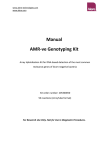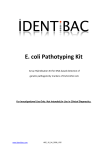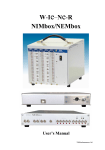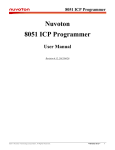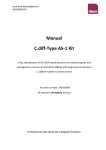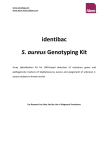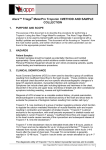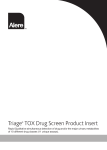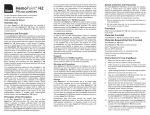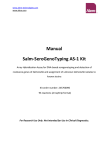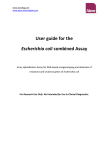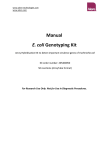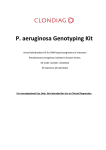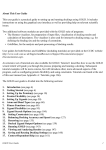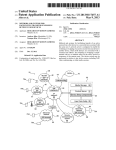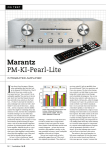Download AMR-ve Genotyping Kit - Alere Technologies GmbH
Transcript
www.alere‐technologies.com AMR‐ve Genotyping Kit Array Hybridisation Kit for DNA‐based detection of the most common resistance genes of Gram‐negative bacteria. For Research Use Only. Not for Use in Diagnostic Procedures. www.alere‐technologies.com CONTENT BACKGROUND ................................................................................................................................. 1 Intended Use ............................................................................................................................ 2 Specifications ........................................................................................................................... 2 Technical Support ..................................................................................................................... 2 Safety Precautions .................................................................................................................... 2 Material Safety Data Sheets (MSDS) ........................................................................................ 3 Shipping Precautions ................................................................................................................ 3 REAGENTS AND DEVICES ................................................................................................................. 4 Kit Components, Storage and Stability .................................................................................... 4 DNA Labelling and Amplification ............................................................................................. 4 Hybridisation and Detection .................................................................................................... 4 Instrumentation & Software .................................................................................................... 5 Components Required but not Provided ................................................................................. 6 PROTOCOL ....................................................................................................................................... 7 Culturing and Harvesting Bacterial Cells .................................................................................. 7 Extraction of DNA ..................................................................................................................... 7 Extraction of DNA by Spin Columns .................................................................................... 8 Extraction of DNA by Automated Device .......................................................................... 10 Linear Amplification and Internal Biotin Labelling ................................................................. 10 Hybridisation procedure ........................................................................................................ 11 General Remarks ‐ Handling of Arrays .............................................................................. 11 General Remarks ‐ Handling of Liquids ............................................................................. 12 General Remarks – the Substrate (Precipitating Dye) D1 ................................................. 13 General Remarks ‐ Thermoshakers ................................................................................... 13 Preparation of the hybridisation mixture ......................................................................... 13 Pre‐washing of the arrays (2 washing steps) .................................................................... 13 Hybridisation ..................................................................................................................... 14 Dilute Streptavidin‐Horseradish‐Peroxidase (C3, C4) ....................................................... 14 Pre‐warm the staining reagent D1 .................................................................................... 14 Washing after hybridisation .............................................................................................. 15 Addition of HRP‐conjugate ................................................................................................ 15 Washing step after binding of conjugate Addition of HRP‐conjugate .............................. 15 Staining of bound HRP‐conjugate ..................................................................................... 16 Data Analysis .......................................................................................................................... 16 Starting the ArrayMate Reader ......................................................................................... 16 Worklist ............................................................................................................................. 18 Data Acquisition in the ArrayMate Reader ....................................................................... 19 Results ............................................................................................................................... 20 Export of Test Results ........................................................................................................ 22 Switch off the device ......................................................................................................... 23 Format of the results (ArrayMate) .................................................................................... 23 AMR‐ve Genotyping Kit 05‐16‐04‐0005‐V06 www.alere‐technologies.com Format of the results (ATR03) ........................................................................................... 24 TROUBLESHOOTING ...................................................................................................................... 25 Staining Control ...................................................................................................................... 25 Image Quality ......................................................................................................................... 25 DNA Quality ............................................................................................................................ 26 Physical Damage to the Array ................................................................................................ 26 ADDITIONAL INFORMATION ......................................................................................................... 26 Warranty ................................................................................................................................ 26 Disclaimer ............................................................................................................................... 27 Quality Control ....................................................................................................................... 27 List of Components for Separate Order ................................................................................. 27 Legal Manufacturer ................................................................................................................ 28 Contact ................................................................................................................................... 28 LITERATURE ...................................................................... FEHLER! TEXTMARKE NICHT DEFINIERT. UPDATES & SOFTWARE ................................................................................................................. 29 APPENDIX 1 ‐ FLOW CHART ........................................................................................................... 30 APPENDIX 2 ‐ GENE LIST ................................................................................................................ 31 AMR‐ve Genotyping Kit 05‐16‐04‐0005‐V06 www.alere‐technologies.com BACKGROUND The AMR‐ve system is a quick and simple method for the detection of the most common resistance genes of Gram‐negative organisms, using an ArrayTubeTM based assay. RNA‐free, un‐fragmented genomic DNA from pure and monoclonal Gram‐negative bacteria (e.g. Escherichia coli or Salmonella enterica) is amplified approximately 40‐fold and internally labelled with biotin‐11‐dUTP using a linear amplification protocol. In contrast to standard PCR, only one antisense primer per target is used resulting in producing single stranded (ss) DNA reaction products. This allows a simultaneous sequence specific labelling and amplification of an essentially unlimited number of targets. However, sensitivity is lower than in a standard PCR (whereas contamination with amplicons is nearly impossible) and for that reason the method is restricted to colony material and cannot be performed on samples such as swabs or pus. Resulting biotin labelled ssDNA is transferred and hybridised to DNA oligonucleotide microarrays with 89 probes for different genetic markers and a biotin staining control. All of them are printed in two spots each. Spot recognition as well as geometric layout is performed automatically based on scans of the arrays and advanced image processing. The target set consists of a variety of antibiotic resistance genes of different Gram‐negative bacteria, family‐specific markers for Enterobacteriaceae and different genus markers for Salmonella, Escherichia and Shigella. AMR‐ve Genotyping Kit 05‐16‐04‐0005‐V06 1 www.alere‐technologies.com GENERAL INSTRUCTIONS FOR USE Intended Use For Research Use Only. Not Intended for Use in Clinical Diagnostics. This kit allows the detection of resistance‐associated genes in isolates of Gram‐negative bacteria/Enterobacteriaceae for research and epidemiological applications. It must not be used as a substitute for phenotypic susceptibility tests and for the guidance of antibiotic therapy. Please note: It cannot be used for Gram‐positives. Specifications Upon receipt, the assay components need to be stored at different temperatures as specified on the package insert. The assay is to be performed at an ambient temperature of 18°C to 28°C. Technical Support If you require any further information on this product please contact: email: [email protected] phone: +49 (0) 3641 3111 – 0 or ‐116 Safety Precautions The kit is intended for use by personnel that are trained in microbiological and molecular methods. Preparation of DNA from bacterial colonies (clones) requires expertise in microbiology and the local regulations for handling of pathogenic microorganisms (usually biosafety level 2) are to be obeyed. Isolated, cell‐free DNA may be processed without further biosafety precautions, although bacterial contaminations need to be ruled out. Always wear protective clothes as required for laboratory work by your local regulations. AMR‐ve Genotyping Kit 05‐16‐04‐0005‐V06 2 www.alere‐technologies.com Material Safety Data Sheets (MSDS) According to OSHA 29CFR1910.1200, Commonwealth of Australia [NOHSC: 1005, 1008(1999)] and the latest amendments to the European Union Directives 67/548/EC and 1999/45/EC, the enclosed reagents do not require a Material Safety Data Sheet (MSDS). They do not contain more than 1% of a component classified as hazardous and do not contain more than 0.1% of a component classified as carcinogenic. MSDS therefore are not provided. Nevertheless, the buffers may cause irritation if they come into contact with eyes or skin, and may cause harm if swallowed. The regular precautions associated with laboratory work should be obeyed (e.g., wear protective goggles, gloves and lab coat and avoid contact with the reagents). In case, any liquids are spilled, clean with disinfectant and/or laboratory detergent and water. Alere assumes no liability for damage resulting from handling or contact with these products. If you have any questions please contact our Technical Support (see above). Shipping Precautions RID/ADR: Kein Gefahrgut / No dangerous goods IMDG: No dangerous goods IATA: No dangerous goods AMR‐ve Genotyping Kit 05‐16‐04‐0005‐V06 3 www.alere‐technologies.com REAGENTS AND DEVICES Kit Components, Storage and Stability All reagents are provided in a certain surplus amount (see below). In case of need, all components may also be ordered separately; please refer to the order numbers at the end of this manual. For pricing please contact your local representative or our customer service, respectively. The expiry date can be found on each bottle and on the outer package. All components have been tested for stability for short term shipment (<1 week) at ambient temperature (< 37 °C). The kit components with a rather limited stability are D1 and C3. The other components have proven to be stable even six months after the kit expiry date has passed. DNA Labelling and Amplification • B1AMR: Labelling Buffer/Master Mix Store at 2‐8°C, Surplus: 40%. • B2: Labelling Enzyme. Store at 2‐8°C, Surplus: 200%. Hybridisation and Detection • ArrayTubes (10 x 5 samples), protected against light and sealed under inert gas. Store at 18°C to 28°C. After opening to be used within two weeks. Close the unused ArrayTubes, protect them against humidity and dust and store them at a dark place. Avoid ANY touching or scratching the microarray on the bottom of the vial. Please note: Do not store or handle unused wells above 60 % relative humidity since this may irreversibly corrode the spots. • C1: Hybridisation Buffer, Store at 18‐28 °C, protect against sunlight. Surplus: 100 %. • C2: Washing Buffer, Store at 18 °C ‐ 28 °C, Surplus: 60 %. • C3: 100x HRP Conjugate, Store at 2‐8 °C, Surplus: 300 %. AMR‐ve Genotyping Kit 05‐16‐04‐0005‐V06 4 www.alere‐technologies.com • C4: Conjugate Buffer. Store at 18°C to 28°C, Surplus: 500 % • C5: Washing Buffer 2. Store at 18°C to 28°C, Surplus: 140 %. • D1: Horseradish Peroxidase Substrate. Store at 2‐8°C, protect against direct sunlight, Surplus: 200 %. • CM (optional, on request): lyophilized DNA of strain E. coli ATCC8739, accession: NC_010468.1 (free of charge) Instrumentation & Software • ArrayMate Reader (to be ordered separately, for details see below) • Alternatively, Reader ATR03 (to be ordered separately, for details see below) • Iconoclust software (provided with the reader) Whilst the AMR‐ve Genotyping kit test runs both on the ArrayMate Reader and on the ATR03 reader, respectively, this manual describes the reading of processed AT on the ArrayMate reader only. If you want to use ATR03, please refer to the latest version of the ATR03 manual or contact us. Test‐specific software package (50103.icpck) contains information such as spot names, marker names, location of the spots on the array, size of the image taken by the reader’s specific camera. This is delivered with the reader or can be downloaded from our website. These test‐ specific plug‐ins will occasionally be updated. Please check periodically the NEWS section of our website http://alere‐technologies.com. Support is available under [email protected] or +49 (0) 3641 3111 – 0 or ‐116. The ArrayMate Reader by default has all software on board. However, the AMR‐ve Genotyping kit specific package 50103.icpck might be missing, e.g., if you obtained the device for the use with another assay. Then you may need to install it separately. It will be provided upon kit order, and can also be downloaded from our website as discussed above. No issues regarding compatibility of software have been observed with the ArrayMate device. AMR‐ve Genotyping Kit 05‐16‐04‐0005‐V06 5 www.alere‐technologies.com The ATR03 reader requires several pieces of software to be installed on an external PC (please refer to the latest version of the ATR03 manual for details). The AMR‐ve Genotyping kit specific package 050103.icpck is not compatible with iconoclust versions older than version 3.1. Components Required but not Provided • Growth media for the cultivation of bacterial isolates. The test should be performed with colonies harvested from 2xTY. Other rich media (e.g. Columbia Blood Agar, Standard 1 or LB) also will suffice, but have not systematically been tested. Equipment and consumables needed for the cultivation of bacteria (incubator, inoculation loops, Petri dishes) • DNA preparation kit The assay has been tested with the DNeasy Blood & Tissue Kit from Qiagen (cat# 69504) and the DNA preparation kit for Qiagen´s EZ1 automated device (cat# 953034). • Equipment needed for DNA isolation, e.g. pipettes, centrifuge, thermoshaker or automated device (see above) • Photometer (OD 260 nm)for measuring the concentration of DNA • Equipment for DNA gel electrophoresis for quality control of DNA • Thermocycler • Thermoshaker We strongly recommend the BioShake iQ by Quantifoil Instruments (http://www.qinstruments.com/) equipped with a customised specialised platform for the warming of the ArrayTubes. Alternatively, you may use Eppendorf’s Thermomixer Comfort, equipped with a platform for the warming of 1.5 ml reaction tubes • Pipettes: suitable for 1µL‐5µL volumes, 90µL, 100µL, 200µL, 1000µL • Multichannel Pipettes for 100‐200 µL • Reagent tubes suitable for PCR • Ultrapure (PCR grade) water AMR‐ve Genotyping Kit 05‐16‐04‐0005‐V06 6 www.alere‐technologies.com PROTOCOL Culturing and Harvesting Bacterial Cells Please note: Enterobacteriacae are potential pathogens. All procedures for cultivation of the bacterium and DNA preparation need to be performed by properly trained staff in a biosafety level 2 facility. Grow bacteria on suitable agar (see above) overnight at 37°C or 48 hrs at room temperature. Make sure that you have a pure, monoclonal culture. Contamination with other bacteria needs to be strictly avoided as this can introduce false positive signals and patterns. • Add an inoculating loop full of monoclonal colony material of the isolate to 0.2 ml 1xPBS and vortex thoroughly. Loop empty Loop full It is important to harvest enough bacteria; this is a prerequisite for extraction of a sufficient amount of DNA. Take an inoculating loop of 1mm diameter filled with bacteria as shown in the left picture. Extraction of DNA Please note: The required specimen for the AMR‐ve Genotyping test is 0.5‐2 µg (cDNA = 0.1‐0.4 µg/µl) of intact DNA from a single clone of Gram‐negative bacteria. This is much more DNA than for standard PCR applications (see Introduction). The DNA specimen needs to be free of RNA and it should not be fragmented. This can be determined by agarose gel electrophoresis. DNA should not be prepared by disrupting cells using bead beaters, ultrasonication or aggressive chemicals such as in alkaline lysis protocols. Most performance problems are due to insufficient amounts or quality of DNA preparation. We therefore strongly recommend following the protocols outlined below. AMR‐ve Genotyping Kit 05‐16‐04‐0005‐V06 7 www.alere‐technologies.com We also recommend performing an experiment with control material (reference DNA of strain E. coli ATCC87393) when establishing the procedure in your lab. This will help to determine the cause of possible problems. Extraction of DNA by Spin Columns • Add 25 µL proteinase K (Qiagen Kit, or equivalent) and add 200 µL buffer AL (Qiagen Kit) • Vortex shortly or shake vigorously. • Incubate for 30‐60 min at 56°C and 550 rpm in the thermoshaker. • Add 4 μl RNase A (100 mg/ml), mix by vortexing, and incubate for 2 min at room temperature before continuing • Add 200 µl ethanol (96‐100%). • Vortex the sample and centrifuge shortly. • Transfer the complete content of the tube into a spin column that is placed in a 2 ml collection tube. • Centrifuge at room temperature, time and speed need to be determined depending on viscosity of the sample and type of centrifuge used. All liquid should be collected in the collection tube afterwards. • Discard collection tube with liquids. • Place the spin column in a new 2 ml collection tube (provided with the kit). • Add 500 µl Buffer AW1. • Centrifuge at room temperature. • Discard collection tube with liquids. • Place the spin column in a new 2 ml collection tube (provided with the kit). • Add 500 µl Buffer AW2. • Centrifuge at room temperature, the membrane of the spin column should be dry, and all liquid should be in the collection tube. • Discard collection tube with liquids. AMR‐ve Genotyping Kit 05‐16‐04‐0005‐V06 8 www.alere‐technologies.com • Place the spin column in a clean 1.5 ml tube (provided with the kit). • Add 50 µl Buffer AE (or PCR grade distilled water) directly onto the membrane of the spin column. • Incubate at room temperature for 1 min to elute DNA. • Centrifuge. • Optional: add another 50 µl Buffer AE (or PCR grade distilled water) directly onto the membrane, incubate at room temperature for 1 min and centrifuge again. • Discard the spin column. Please note: Ethanol from Washing Buffers strongly inhibits the enzymes used in the assay. A contamination with washing Buffer might occur during elution of prepared DNA by drops adhering to the funnel of the spin columns. Thus these funnels should be gently touched and tried with sterile filter paper or wipes prior to the elution step. Alternatively, prepared DNA can shortly be heated to evaporate ethanol (e.g., 10 min at 70°). • Check for DNA integrity and absence of RNA (e.g., agarose gel). If necessary, you might perform another digestion step with additional RNase A (not provided). Measure DNA concentration (A260 method), it shouldn´t be less than 0.1 µg/µl. The concentration might be increased by heating and evaporation of water, or by using a speed vac centrifuge. AMR‐ve Genotyping Kit 05‐16‐04‐0005‐V06 9 www.alere‐technologies.com Extraction of DNA by Automated Device The assay has been tested with Qiagen´s EZ1. Other systems also can be used. However, performance should be checked with some known reference strains prior to routine use. • Add 10 µl proteinase K and add 100 µl buffer AL to harvested bacteria. • Vortex shortly or shake vigorously. • Incubate sample, 45‐60 min at 56 °C and 550 rpm in the thermomixer. • Add 4 μl RNase A (100 mg/ml), mix by vortexing, and incubate for 2 min at room temperature before continuing • When the cells are lysed, proceed by performing the tissue lysis protocol (Bacteria card) for Qiagen´s EZ1 • For Qiagen´s EZ1: Front row: empty elution tubes (1.5 ml); Second row: tip holder with tips; Third row: empty; Back row: sample tube with conical tip (2 ml) with the 200 µl sample volume. Set tissue lysis protocol with a set sample volume of 200 µl and an elution volume of 50 µl. • Concentrate DNA and evaporate traces of solvents by heating the sample, at 70 °C for 5‐10 minutes. Linear Amplification and Internal Biotin Labelling Please keep in mind the limited surplus of reagents whilst pipetting. The surplus of B1AMR labelling reagent is 25%. • Prepare a Master Mix by combining 4.9 µL of B1AMR labelling reagent and 0.1 µL of B2 (DNA polymerase) per sample. • Add 5 µl DNA (0.5‐2 µg) prepared as described above to a 5 µL aliquot of the mastermix. Do not forget to label the vial! • Perform amplification in a pre‐programmed thermocycler (such as Mastercycler gradient with heated lid, VWR, cat No. 460‐0108) according to following protocol: Pre‐heat cover/lid to 105°C AMR‐ve Genotyping Kit 05‐16‐04‐0005‐V06 10 www.alere‐technologies.com 300 sec at 96°C 20 sec at 50°C 45 cycles with 30 sec at 72°C 20 sec at 96°C Cool down to 4°C, hold Please note: When using another device, some adaptations might be necessary. Before starting routine use, please test the protocol with a few known reference strains and the control DNA supplied with the kit. Hybridisation procedure General Remarks ‐ Handling of Arrays Please note: Never touch the array surface! Avoid complete drying of the array surface during processing! Do not allow it to stay without liquid for more than two minutes! Never rinse the wells with distilled water after hybridisation step, use C2 washing buffer only! Always label your ArrayTubes with a laboratory marker at the recommended position. Never label them on the bottom or across the data matrix barcode! This may cause an error. Avoid contact of data matrix barcode with organic solvents! The ArrayMate needs the information encoded in the data matrix to perform the assay. AMR‐ve Genotyping Kit 05‐16‐04‐0005‐V06 11 www.alere‐technologies.com Avoid touching the bottom of the microarray and keep it clean. General Remarks ‐ Handling of Liquids We recommend the use of a multichannel pipette and reagent reservoirs. Please keep in mind the limited surplus of C1 (100%). We strongly recommend that the liquid is removed by pipetting rather than by inverting the ArrayTube and flicking the liquids out. Fine tipped soft, disposable Pasteur pipettes are suited best (such as VWR Best.nr: 612‐2856). Always place the pipette tip at the cavity between the array and the wall of the reagent well. If you touch the array surface, probes may be scratched off and this may cause an error. AMR‐ve Genotyping Kit 05‐16‐04‐0005‐V06 12 www.alere‐technologies.com General Remarks – the Substrate (Precipitating Dye) D1 An appropriate amount of substrate (precipitating dye) should be filled into an Eppendorf tube and taken out of the refrigerator when starting the procedure allowing it to pre‐warm to room temperature/25°C. Cold D1 may yield weak signals. D1 should shortly be centrifuged prior to use to remove bubbles as well as possible precipitates. Triggered by peroxidase, in case of positive reactions, the dye precipitates but it is not covalently bound. The precipitate can be dissolved by vigorous shaking. Thus the arrays must not be shaken, dropped or moved abruptly during the staining procedure and afterwards. After completion of staining, remove and discard reagent D1 as completely as possible and scan immediately. The dye precipitate fades slowly in presence of liquids. General Remarks ‐ Thermoshakers The correct temperature within the vessels is essential; therefore always use the appropriate equipment for heating. Because of a possibly inhomogeneous distribution of the temperature within the heating block and because of possible differences between displayed and actual temperatures, the use of different brands of thermoshakers might affect test performance. We tested the assay with BioShake iQ by Quantifoil Instruments (http://www.qinstruments.com/) equipped with a customised heating block designed to fit ArrayTubes and Eppendorf’s Thermomixer Comfort, equipped with a heating block for 1.5 ml Eppendorf tubes. Thus we recommend the use of either device. When using other devices, some modifications to the protocol might be necessary. Before starting routine use, please test the protocol with a few known reference strains or the control DNA supplied with the kit. Preparation of the hybridisation mixture • Pre‐heat the thermoshaker to 55 °C • Add 90 µL of buffer C1 to each labelling product, mix gently (vigorous mixing results in foaming) and put aside. Pre‐washing of the arrays (2 washing steps) • Remove the ArrayTube from the bag (open the bag at its predetermined breaking point) AMR‐ve Genotyping Kit 05‐16‐04‐0005‐V06 13 www.alere‐technologies.com • Add 500 µL of ultrapure water to each tube • Incubate in the thermoshaker at 55 °C, 550 rpm for 2 minutes • Remove and discard the water WITHOUT TOUCHING THE ARRAY SURFACE • Add 500 µL buffer C1 to each tube • Incubate in the thermoshaker at 55 °C, 550 rpm for 4 minutes • Remove and discard buffer C1 • Proceed promptly (hybridisation mixtures must be ready when buffer C1 is removed) Hybridisation • Transfer each hybridisation mixture (100 µL) to a prepared ArrayTube (avoid extensive foaming) • Incubate for one hour at 55°C and 550 rpm on a thermoshaker Dilute Streptavidin‐Horseradish‐Peroxidase (C3, C4) • Combine reagent C3 (Streptavidin‐Horseradish‐Peroxidase) and Buffer C4 in a ratio of 1:100, the mixture is stable for 1 day at room temperature; C3 is delivered with a surplus of 300 %, C4 is delivered with a surplus of 500 %. Pipetting scheme: ArrayTubes (AT) 1 AT 2‐3 ATs 4‐6 ATs 7‐10 ATs 11‐15 ATs C3 1.5 µL 3.5 µL 7 µL 11 µL 16 µL C4 150 µL 350 µL 700 µL 1100 µL 1600 µL • put aside at room temperature until use Pre‐warm the staining reagent D1 • Transfer enough reagent D1 into a separate vessel (e.g. a clean and sterile centrifuge tube), 100 µL for each well and a surplus of not more than 20 % • Put aside at 20 to 25°C until use. AMR‐ve Genotyping Kit 05‐16‐04‐0005‐V06 14 www.alere‐technologies.com Washing after hybridisation • Please keep in mind the limited surplus of C2 (60 %) • Remove the ArrayTubes from the thermoshaker • Set the thermoshaker to 30°C for the following steps • Carefully open the tubes and remove the hybridisation mixture as completely as possible (without touching the array surface) • 1nd Washing step after hybridisation: add 500 µL of buffer C2 and incubate in the thermoshaker for 5 min at 30 °C, 550 rpm, remove and discard the washing solution • 2nd Washing step after hybridisation: repeat 1nd Washing step Please note: a carryover of more than 1 % of buffer C1 to the next step will denature the HRP Addition of HRP‐conjugate Please note: Reagent C3 contains Streptavidin‐Horseradish Peroxidase (HRP) that would denature and lose its activity at 55°C. Do NEVER incubate above 30°C. Make sure that the thermoshaker has cooled down before mounting the ArrayTubes! Please keep in mind the limited surplus of C3 (300 %) • Add 100 µL of prepared C3/C4 mixture to each tube • Incubate for 10 minutes at 30°C and 550 rpm on a thermoshaker • Remove and discard C3/C4 mixture completely Washing step after binding of conjugate Addition of HRP‐conjugate • Please keep in mind the limited surplus of C5 (140 %) • 1nd Washing step after conjugation: add 500 µL of buffer C5, shake for 1 minute at 30°C and 550 rpm on a thermoshaker, remove and discard the washing solution • 2nd Washing step after conjugation: Repeat 1nd Washing step. Please note: a carryover of more than 0.5 % of C3/C4 into the following staining reagent will create black particles which in the worst case may mimic signals (hybridised AMR‐ve Genotyping Kit 05‐16‐04‐0005‐V06 15 www.alere‐technologies.com spots). On the same time, real signals may appear pale due to competition of soluble Horseradish Peroxidase with the DNA‐bound enzyme for substrate molecules. Staining of bound HRP‐conjugate Please note: A carryover of more than 0.5 % of C3/C4 will cause unwanted effects (see above) on the array surface. Please do not move ArrayTubes during staining. The reagent D1 contains a substrate for Horseradish Peroxidase and please keep in mind the limited surplus of D1 (200 %). • D1 needs to be pre‐warmed and centrifuged, see section 5 • Add 100 µL of reagent D1 to each well (supernatant of centrifuged D1 without precipitate) • Incubate at room temperature WITHOUT agitation for 10 min • Read out WITHOUT removing D1 (removal of D1 would leave air bubbles within the tubes) Please note: The ArrayTubes as used in this kit do have a different geometry than the 8‐well ArrayStrips that are used in other kits. Therefore, unlike the directive for ArrayStrips, D1 is NOT to be removed from the ArrayTubes before reading. Dust on the bottom side of the ArrayTube can remove using a cleanroom wiper. Data Analysis Starting the ArrayMate Reader We recommend starting the ArrayMate Reader after having started the hybridisation; this allows you to conveniently start the device and to import the worklist file (see below) Please note that this is a short instruction only. For more detailed information please refer to the ArrayMate User Manual. • Switch on the ArrayMate (main switch on the rear below the electric cable plug, operating switch on the bottom/left corner of the front side). AMR‐ve Genotyping Kit 05‐16‐04‐0005‐V06 16 www.alere‐technologies.com • Switch on the screen (switch right hand below the screen). • Log‐in as “R&D User” (Research and Development User) for full access to test specific software (a default password will be provided together with the ArrrayMate device) If you log‐in as “User”, you will obtain only raw values, but no interpretation as positives/negatives and no strain assignment. “Administrator” log‐in will allow manipulation of file folders and software; and this should be done only upon direct advice of Alere Technologies´ IT team. • The user interface will be loaded, ArrayMate performs internal testing. This will require slightly less than a minute. • Click on the icon “New Run” (left upper edge of the screen). A suggestion for a run name / folder name for the new run appears in the top line of the screen). You may modify or change the experiment name at your convenience. • Type in your operator ID (optional). • You may enter a comment into the “memo” field (optional). AMR‐ve Genotyping Kit 05‐16‐04‐0005‐V06 17 www.alere‐technologies.com Worklist A “Worklist” file allows linking an identifier such as a laboratory/sample number to a position of an ArrayTube within the metal frame to be used for reading in the ArrayMate. For privacy reasons, arrays should not be identified by patient names. Worklists can be generated using spreadsheet software such as EXCEL (see below) but must be saved in the *.txt file format that can be imported into the test specific ArrayMate software. Do not use special characters (such as : ; ()[] / \ ä ü etc.). • Create a list with at least three columns that have headers written into the first line. The following headers are obligatory (in this order): position / sample ID / assay ID (Table 1). • Positions are continuously numbered from 1 to 6 of the metal frame to be used for reading in the ArrayMate. Do not leave empty lines in the worklist. If you use EXCEL, position numbers should be typed into column A. • Sample ID are strain/sample/laboratory numbers such as exported from your LIMS (or assigned in any different way). Patient´s names should not be used as Sample IDs. • Assay IDs allow the system to identify the actual test and to correctly use information on layout, spot number and identity etc. The present kit has the Array ID 050103. This must not be confused with Assay IDs of other tests as this could lead to errors or loss of data. • You may add further columns and headers with notes and comments at your convenience Information from these columns will not appear on the result screens or the Test Report. • We recommend using a printout of the worklist as template for pipetting. • Safe the worklist as *.txt file on the memory stick provided together with the ArrayMate. • To avoid confusion, make sure that worklists are named unambiguously or that worklists from earlier experiments are deleted. AMR‐ve Genotyping Kit 05‐16‐04‐0005‐V06 18 www.alere‐technologies.com Table 1: Example worklist: Position sampleID assayID comment 1 2013‐12345 050103 Dr. Jones 2 2013‐12346 050103 Dr. Miller 3 2013‐12347 050103 Dr. Yale 4 2013‐12348 050103 Dr. Palmer 5 2013‐12349 050103 Dr. Jones 6 2013‐12350 050103 Dr. Jones Data Acquisition in the ArrayMate Reader • Insert your memory stick containing the worklist. Use any of the USB ports down to the right side of the ArrayMate. • Press the button: • Select your worklist (path: “My Computer/Removable Disk”). • Open your selected worklist with “Enter” or the button “Open”. • Press the button: ; a folder selection dialog will open. (your imported worklist opens in a separate window). Proofread. If the new window is empty or if it was the wrong worklist, repeat the import. • Press the button “OK”; the worklist window will close. • Leave the memory stick attached to the ArrayMate if you intend to export Genotyping Test Reports afterwards. • Press the button “next” (bottom/right on the screen; reader is opening). • Carefully insert the appropriate metallic adapter for ArrayTubes into the ArrayMate. Do not apply any strong force. • After having inserted the adapter, carefully insert the Array Tubes into the adapter. • ArrayTubes need to be open with tube‐lid connections placed into appropriate notches: AMR‐ve Genotyping Kit 05‐16‐04‐0005‐V06 19 www.alere‐technologies.com • Assure proper fit, otherwise the images may be out of focus. • Barcodes on ArrayTubes and holder must be clean. • Press the button “Next” (bottom/right on the screen; reader is closing, analysis program starts, it takes ca. 2‐10 min dependent on the number of arrays; reader takes images and automatically analyses the data). The progress of the reading is indicated by the following symbols: photographed: in analysis: ready: • The reader indicates the end of the entire process with an acoustic signal (beep). • Press the button “Next” (bottom/right on the screen; reader is opening). • Remove the frame with the arrays. • Press the button “Next” (bottom/right on the screen; reader is closing). Results On the left hand side of the screen you will see a list showing all readings stored on the ArrayMate. A reading contains the results from all arrays analysed together in one frame. If this list is not visible: press the button “Archive” (left hand side) or activate the Flag “Browse” (top left). AMR‐ve Genotyping Kit 05‐16‐04‐0005‐V06 20 www.alere‐technologies.com The readings are organised like folders in “Windows”. Example: there are several readings in the archive, by default they are named by date and time of day of creation (which you may have changed, see section “setup of the ArrayMate reader”): Click onto the plus symbol of one defined reading, the folder opens and you will see a list of the individual ArrayTube(s) (sorted by position within the adapter) Activate the Flag “raw data” (top left) and click onto the position of an individual tube (e.g. 01‐ A), the results of this particular array will appear on the right side of the window: Note: the flags “results” and “results b” are not active with this assay. Interpretation of the “raw data” list: AMR‐ve Genotyping Kit 05‐16‐04‐0005‐V06 21 www.alere‐technologies.com • Spot ID: numerical identifier of the spot on the array • Substance: name of the DNA probe • Confidence: an intrinsic estimate of spot confidence based on size and shape of that particular spot, where 1 = high confidence and 0 = no confidence • Signal: spot signal intensity (grey scale value), where 1 = black and 0 = white • Valid: 0 = valid; 1 = invalid (confidence below 0.75) • Background: luminous intensity of the background, where 1 = maximum brightness and 0 = maximum darkness • Mean: luminous intensity of the signal (spot), where 1 = maximum brightness and 0 = maximum darkness Please note: The correlation between mean, background and signal is roughly: 1‐mean/background, however, there are some correction factors that depend on the statistics of pixel distribution. Export of Test Results Please note: only complete readings can be exported. The export of Test results for individual ArrayTubes of a reading is not possible • Right‐Click on the desired reading (a menu appears with the option “Export Run”) • Right‐Click on “Export Run” (a file browser opens) AMR‐ve Genotyping Kit 05‐16‐04‐0005‐V06 22 www.alere‐technologies.com • Click on “My Computer”, then on “Removable Disk” and choose an appropriate storage place • Click on the button “Make New Folder” (on the bottom; a new folder icon appears) • Rename the new folder(e.g. with the experiment name) • Click on the ”Ok” button (data are exported now into the new folder on your memory stick) • Do NOT remove the memory stick as long as the hourglass symbol is visible. Switch off the device • Click on the “Power”‐button (left/down on the screen): • Switch off the Screen. There is no need to physically switch off the ArrayMate. Format of the results (ArrayMate) The ArrayMate creates a test report that lists all markers that have been analysed along with an individual test result for each marker. AMR‐ve Genotyping Kit 05‐16‐04‐0005‐V06 23 www.alere‐technologies.com Format of the results (ATR03) From October 2011 (after software update) also ATR03 will create a user‐friendly test report. Up to then the result file that is exported from the ATR03 may be transformed into an Excel‐ compatible format like this: Spot ID 4 5 6 7 8 9 10 11 12 15 19 20 21 Substance prob_qnr_11 prob_sul2_11 prob_sul3_11 prob_tetA_11 prob_tetB_11 prob_tetC_11 prob_tetD_1 prob_tetE_11 prob_tetG_11 prob_tetG_12 prob_intI1_1 prob_intI2_11 prob_aadA1_1 Confidence 1.000000 1.000000 0.912418 0.819785 0.944766 1.000000 1.000000 0.518164 0.659604 0.854373 1.000000 1.000000 1.000000 Signal 0.886892 0.898004 0.003430 ‐0.000355 0.876103 0.004679 0.015125 ‐0.006598 ‐0.002998 0.002434 0.896929 0.000487 0.891626 Valid 0 0 0 0 0 0 0 0 0 0 0 0 0 Background 0.871648 0.878958 0.890318 0.889951 0.891758 0.900523 0.903089 0.906068 0.908184 0.912519 0.880351 0.889894 0.882046 Mean 0.050474 0.040523 0.887074 0.890286 0.061860 0.896046 0.888580 0.912418 0.911075 0.910160 0.041592 0.889434 0.046642 0.001133 0.870413 0.893219 0.899675 0.002659 0 0 0 0 0 0.909988 0.899323 0.893825 0.903183 0.910709 0.908893 0.067820 0.045752 0.040036 0.908137 . . . 104 105 106 107 108 0,1M NaPP Standard pH 9 Biotin‐Marke_2,5µM prob_qnr_11 prob_sul2_11 prob_sul3_11 0.890874 1.000000 1.000000 1.000000 0.944766 • The meaning of the columns of the raw data list has been outlined above. Please note, that each substance is represented by two spots, e.g. substance prob_qnr_11 is represented by the spots #4 and #106, respectively. • Spots #104 and #209, respectively contain substance “0,1M NaPP Standard pH 9” which is a negative control, i.e. “Signal” of these spots should be far below 0.1. • Spots #105 and #210, respectively contain substance “Biotin‐Marke_2,5µM” which is a positive control, i.e. “Signal” of these spots should be above 0.5. • For the meaning of the other substances/spots please refer to our gene list (Appendix 2). AMR‐ve Genotyping Kit 05‐16‐04‐0005‐V06 24 www.alere‐technologies.com TROUBLESHOOTING In case of trouble always make sure that reagents are within the recommended shelf‐life and stored in the appropriate way. In case of trouble we are always happy to support. Please contact [email protected] (or +49 (0) 3641 3111 ‐ 0 or ‐116), and please include a description of the problem as well as the array images (*.bmp files) in question. Staining Control A staining control is included to check whether possible problems originate from the hybridisation or the staining procedure. If the staining control has “Failed” proceed as follows: Horseradish peroxidase conjugate may have degraded during storage. Add 1µL buffer C3/C4 to 9 µL D1 (substrate). If the solution turns green within 3‐5 seconds, the horseradish peroxidase still has sufficient enzymatic activity. Enzymatic reaction is inhibited by carryover of buffer C1. Ensure proper washing of the wells to remove all of Buffer C1 prior to adding horseradish peroxidase conjugate. Image Quality In case of poor image quality we recommend to re‐check DNA quantity and quality first by loading leftover DNA on an agarose gel. In order to determine whether any problems originated from the DNA preparation, you might perform an experiment with the Control Material (CM, optional). This is DNA from the reference strain E. coli ATCC87393 (accession: NC_010468.1). It is be provided free of charge upon request. If the control experiment yields a valid result and a correct identification of probes gapA, ihfA, dnaE and hemL, there was probably an issue with DNA preparation. If the control experiment also fails, an error affecting later steps or a degradation of reagents from later steps is likely. AMR‐ve Genotyping Kit 05‐16‐04‐0005‐V06 25 www.alere‐technologies.com DNA Quality The amount of DNA is crucial because of the linear kinetics of amplification (see Introduction). DNA should be free of RNA, as free RNA reduces the efficiency of amplification and labelling by effectively removing primer from the reaction mix due to competitive hybridisation. A260 readings will cover RNA and other contaminants as well. Therefore pure DNA preparations without RNA contaminations are a prerequisite for proper DNA concentration measurement. RNAse treatment prior to A260 reading therefore is necessary (component A2 contains RNAse). DNA must be unfragmented, as fragmentation reduces the efficiency of amplification and labelling due to the distance between primer and probe binding sites. DNA should for this reason not be prepared by disrupting bacterial cells using bead beaters, ultrasonication or aggressive chemicals such as in alkaline lysis protocols. We made good experiences with the manual QIAGEN DNeasy kit and the automated device EZ1. DNA must be free of any traces of ethanol, as ethanol strongly influences the amplification. It is possible to heat the sample prior to adding it to the labelling mix (5‐10 minutes at 70°C). Some problems with samples from the Qiagen EZ1 device for example were resolved after heating the samples (see above). Physical Damage to the Array Scratching of the array surface with a pipette tip can lead to the damage of array spots that prohibits the acquisition of a valid signal. In this case the respective marker is not assigned as “negative”, but instead the message “none” appears next to the marker name. ADDITIONAL INFORMATION Warranty Alere guarantees the performance as described in this manual. Usage of the Kit was successfully tested at ambient temperatures up to 37 °C, a guarantee is limited to ambient temperatures in the laboratory between 18 °C and 28 °C. Kit components comprise the AMR‐ve Genotyping Kit 05‐16‐04‐0005‐V06 26 www.alere‐technologies.com ArrayTubes, the reagents for DNA labelling and for detection of labelled DNA products on the array, the ArrayMate reader and its software. In case one of these components fails within the expiry date due to other reason than misuse, contact Alere for replacement or refund. Terms and conditions apply. If you have any problem or question, please contact the technical service. Disclaimer This system is for research use only. We do not accept any liability for damages caused by misuse. Misuse comprises, especially but not exclusively, of a use of the system for the detection of resistance genes in order to predict phenotypic antibiotic resistances or susceptibilities for the guidance of an antibiotic chemotherapy. Since resistances might be caused by genes or mutations not covered by this array or by hitherto unknown genes or mutations, any antibiotic chemotherapy MUST be guided by phenotypic susceptibility tests. Furthermore, we do not accept any liability for damages caused by inappropriate use of the device as a personal computer, for instance related to the use of additional software, to network connections, or to a breach of privacy related to the storage of confidential information (such as names of patients) on its hard disk and/or to the use of external storage devices that might be contaminated with spyware. Quality Control Each batch is stringently tested with the use of standard DNA preparations for good performance and correctness of results. List of Components for Separate Order If required, these reagents may be ordered separately: component name AMR‐ve Genotyping Kit 05‐16‐04‐0005‐V06 Category amount cat# storage 27 www.alere‐technologies.com B1AMR Labelling Buffer buffered reagents 360 µl 245503000 2‐8 °C B2 C1 C2 C3 C4 C5 D1 CM Labelling Enzyme Hybridisation Buffer Washing Buffer 1 HRP Conjugate 100x Conjugate Buffer Washing Buffer 2 HRP Substrate Control Material 20 µl 30 ml 120 ml 200 µl 30 ml 120 ml 15 ml 30 µl 245104000 245105000 245106000 245107000 245108000 245109000 245110000 2‐8 °C 18‐28 °C 18‐28 °C 2‐8 °C 18‐28 °C 18‐28 °C 2‐8 °C 2‐8 °C ArrayTubes Array AMR‐ve buffered enzyme buffered reagents buffer buffered enzyme buffered reagents buffer buffered reagents E. coli strain ATCC8739 DNA (cDNA = 0.1‐0.4 µg/µl) microarrays 50 St 20100 15‐28 °C For pricing please contact your local representative or our customer service, respectively. Legal Manufacturer Alere Technologies GmbH Loebstedter Str. 103‐105 07749 Jena, Germany Contact If you require any further information on this product please contact [email protected] AMR‐ve Genotyping Kit 05‐16‐04‐0005‐V06 28 www.alere‐technologies.com LITERATURE 1. Development of a miniaturised microarray‐based assay for the rapid identification of antimicrobial resistance genes in Gram‐negative bacteria. Batchelor M, Hopkins KL, Liebana E, Slickers P, Ehricht R, Mafura M, Aarestrup F, Mevius D, Clifton‐Hadley FA, Woodward MJ, Davies RH, Threlfall EJ, Anjum MF; Int J Antimicrob Agents. 2008 Feb 1. 2. Identifying antimicrobial resistance genes of human clinical relevance within Salmonella isolated from food animals in Great Britain. Muna F. Anjum, Suman Choudhary, Victoria Morrison, Lucy C. Snow, Muriel Mafura, Peter Slickers, Ralf Ehricht and Martin J. Woodward; J. Antimicrob. Chemother. (2011) For further literature please refer to: http://alere‐technologies.com/en/science‐technologies/publications/ UPDATES & SOFTWARE Notifications on database/software updates and freeware tools can be found at: http://alere‐technologies.com/en/science‐technologies/publications/downloads.html. and/or http://alere‐technologies.com/en/news.html. AMR‐ve Genotyping Kit 05‐16‐04‐0005‐V06 29 www.alere‐technologies.com APPENDIX 1 ‐ FLOW CHART The figure on this page summarises the test procedure. However, please refer to the text section of this user guide at any step of the test protocol for further important details. prepare DNA prepare ArrayTubes pro‐ cessing time hands‐ on‐ time over night 10 min isolate genomic DNA (not part of the kit) 3‐4 h 40 min rinse ArrayTubes 500 µl water; 55 °C, 550 rpm, 2 min label RNA free DNA in thermocycler 5 µl DNA (cDNA = 0.1 ‐ 0.4 µg/µl) plus MM (4.9 µL B1AMR + 0.1 µL B2) 2‐3 h 10 min discard water; 500 µl Buffer C1; 55 °C, 550 rpm, 4 min discard C1, process promptly preparing labeled DNA to 10 µL of labeled DNA add 90 µL of Buffer C1 10 min 10 min transfer 100 µl labeled DNA to ArrayTube 2 min 2 min hybridise; 55 °C, 550 rpm; 60 min 60 min 0 min discard labeled DNA; incubate twice in 500 µl Buffer C2; 30 °C, 550 rpm, 5 min; prepare C3/C4‐conjugate (C3:C4=1:100), preheat Substrat D1 (25°C) 15 min 10 min discard Buffer C2; incubate in 100 µl C3 /C4‐conjugate; 30 °C, 550 rpm, 10 min 10 min 2 min discard C3/C4‐conjugate; incubate twice in 500 µl Buffer C5; 30 °C, 550 rpm, 1 min 5 min 5 min discard Buffer C5; incubate with 100 µl Substrate D1; 25 °C, 10 min 10 min 2 min take image WITHOUT removing D1, analyse 5 min 2 min Quantif oil BioShake iQ or Eppendorf Thermomixera Grow CLONAL bacteria isolate (not part of the kit) MM ‐ MasterMix PM ‐ PrimerMix a) with heating block for 1.5 ml Eppendorf AMR‐ve Genotyping Kit 05‐16‐04‐0005‐V06 total time requirement : over night app. 120 min + 7‐8 h tubes 30 www.alere‐technologies.com APPENDIX 2 ‐ GENE LIST Description1,2 AMR family Gene Probe Synonym acetyltransferase vatE hp_vatE_611 vatE‐3; vatE‐4; acetyltransferase;streptogramin A vatE‐5; vatE‐6; acetyltransferase; associated with resistance to vatE‐7; vatE‐8; satG streptogramin A (AF242872.1) acetyltransferase vatE hp_vatE_612 vatE‐3; vatE‐4; acetyltransferase;streptogramin A vatE‐5; vatE‐6; acetyltransferase; associated with resistance to vatE‐7; vatE‐8; satG streptogramin A (AF242872.1) aminoaminoglycoside aac resistance prob_aac3Ia_1 aacC1 3‐N‐aminoglycoside acetyltransferase; associated with resistance to astromicin; gentamicin; sisomicin (U90945.1) aminoaminoglycoside aac resistance prob_aac3IVa_1 aacC4 3‐N‐aminoglycoside acetyltransferase; associated with resistance to apramycin; dibekacin; gentamicin; netilmicin; sisomicin; tobramycin (EU784152.1) aminoaminoglycoside aac resistance prob_aac6Ib_1 aacA4 aminoglycoside 6'‐N‐acetyltransferase; associated with resistance to streptomycin, spectinomycin (M21682.1) aminoaminoglycoside aadA prob_aadA1_1 resistance aadA1 aminoglycoside adenyltransferase; associated with resistance to streptomycin, spectinomycin (EU704128.1) aminoaminoglycoside aadA prob_aadA2_1 resistance aadA2a; aadA2b; aadA2c; aadA3; aadA8 aminoglycoside adenyltransferase; associated with resistance to streptomycin, spectinomycin (EU704128.1) aminoaminoglycoside aadA prob_aadA4_1 resistance aadA5 aminoglycoside adenyltransferase; associated with resistance to streptomycin, spectinomycin (EU704128.1) aminoaminoglycoside ant2 prob_ant2Ia_1 resistance aadB aminoglycoside (2'') adenylyltransferase; associated with resistance to dibekacin; gentamicin; kanamycin; sisomicin; tobramycin (L06418.4) aminoaminoglycoside strA resistance prob_strA_611 aph3 aminoglycoside‐3''‐phosphotransferase (locus A); associated with resistance to streptomycin (EF090911.1) aminoaminoglycoside strB resistance prob_strB_611 aph6 aminoglycoside‐6''‐phosphotransferase; associated with resistance to streptomycin (EF090911.1) beta lactam resistance acc prob_acc2_11 class C beta‐lactamase (EF554600.1) beta lactam resistance acc prob_acc1_11 beta lactam resistance act1 prob_act1_11 blaACC‐1; ACC‐1a4; ACC‐2; ACC‐4 blaACC‐1; ACC‐1a4; ACC‐2; ACC‐4 blaACT‐1; ACT‐2; ACT‐3; MIR‐8; Mir2; Mir4 AMR‐ve Genotyping Kit 05‐16‐04‐0005‐V06 class C beta‐lactamase (EF554600.1) class C beta‐lactamase (U58495.2) 31 www.alere‐technologies.com beta lactam resistance cmy prob_cmy_11 consensus sequences to blaCMY‐13, blaCMY‐2, blaCMY‐24, blaCMY‐35, blaCMY‐CFE1, blaCMY‐CFE2 (Citrobacter spp.), blaCMY‐Cmur (Citrobacter murliniae), blaCMY‐Cwer (Citrobacter werkmanii), blaCMY‐Cyou (Citrobacter youngae), blaCMY‐HG3, blaCMY‐HG4 beta lactam resistance cmy hp_blaCMY_611 consensus sequence to blaCMY‐13, blaCMY‐2, blaCMY‐24, blaCMY‐35, blaCMY‐CFE1, blaCMY‐CFE2 (Citrobacter spp.), blaCMY‐Cmur (Citrobacter murliniae), blaCMY‐Cwer (Citrobacter werkmanii), blaCMY‐Cyou (Citrobacter youngae), blaCMY‐HG3, blaCMY‐HG4 beta lactam resistance cmy hp_blaCMY_612 consensus sequence to blaCMY‐13, blaCMY‐2, blaCMY‐24, blaCMY‐35, blaCMY‐CFE1, blaCMY‐CFE2 (Citrobacter spp.), blaCMY‐Cmur (Citrobacter murliniae), blaCMY‐Cwer (Citrobacter werkmanii), blaCMY‐Cyou (Citrobacter youngae), blaCMY‐HG3, blaCMY‐HG4 beta lactam resistance ctx prob_ctxM1_11 beta lactam resistance ctx beta lactam resistance ctx beta lactam resistance ctx beta lactam resistance ctx ctxM15; ctxM28; ctxM29; ctxM3; ctxM32; ctxM33; men‐1 prob_ctxM1_12 ctxM15; ctxM28; ctxM29; ctxM3; ctxM32; ctxM33; men‐1 prob_ctxM9_11 ctxM13; ctxM14; ctxM16; ctxM17; ctxM18; ctxM21; ctxM24; ctxM27; ctxM51; ctxM9a; ctxM9b; KLUY‐2; KLUY‐3; KLUY‐4 prob_ctxM2_11 ctxM20; ctxM3; ctxM35; ctxM5; ctxM6 prob_ctxM26_11 ctxM25; ctxM39; ctxM41 extended spectrum beta lactamase, class A beta‐ lactamase (X92506.1), including ctxM15 (HQ202266.1) extended spectrum beta lactamase, class A beta‐ lactamase (X92506.1), including ctxM15 (HQ202266.1) class A beta‐lactamase (AF174129.3) extended‐spectrum beta‐lactamase CTX‐M2, class A beta‐lactamase (AM040709.1) extended spectrum beta lactamase, class A beta‐ lactamase (AF518567.2) beta lactam resistance ctx prob_ctxM8_11 blaKLUG‐1; ctxM40; ctxM63 extended spectrum beta lactamase, class A beta‐ lactamase (AY750914.2 ) beta lactam resistance dha prob_dha1_1 DHA‐1; DHA‐2 class C beta‐lactamase (EF406115.1) beta lactam resistance fox prob_fox_11 FOX‐5; FOX‐7 consensus sequence for blaFOX genes (AJ703795.1) beta lactam resistance len prob_len1_11 blaLEN class A beta‐lactamase (AY743416.1) beta lactam resistance fox prob_mox_1pm blaFOX consensus sequence for blaFOX genes (AJ703795.1) beta lactam resistance mox prob_mox_1mm blaMOX consensus sequence to all blaMOX genes beta lactam resistance mox hp_blaMOX‐ CMY9_611 ampC; blaCMY‐10; blaCMY‐9; MOX‐4 class C beta‐lactamase, extended‐spectrum beta‐ lactamase precursor, associated with resistance to cephalosporins (AF381617.1) beta lactam resistance mox hp_blaMOX‐ CMY9_612 ampC; blaCMY‐10; blaCMY‐9; MOX‐4 class C beta‐lactamase, extended‐spectrum beta‐ lactamase precursor, associated with resistance to cephalosporins (AF381617.1) AMR‐ve Genotyping Kit 05‐16‐04‐0005‐V06 32 www.alere‐technologies.com beta lactam resistance mox hp_blaMOX‐ CMY9_613 ampC; blaCMY‐10; blaCMY‐9; MOX‐4 class C beta‐lactamase, extended‐spectrum beta‐ lactamase precursor, associated with resistance to cephalosporins (AF381617.1) beta lactam resistance oxa prob_oxa1_21 beta‐lactamclass D beta‐lactamase OXA‐1 (AY458016.1) beta lactam resistance oxa prob_oxa2_11 beta lactam resistance oxa prob_oxa7_11 blaOXA‐1; blaOXA‐ 30; blaOXA‐31; blaOXA‐33 blaOXA‐2; blaOXA‐3; blaOXA‐15; blaOXA‐ 20; blaOXA‐ 21, blaOXA‐ 22; blaOXA‐ 32; blaOXA‐ 34; blaOXA‐36 blaOXA‐35 beta lactam resistance oxa prob_oxa9_11 blaOXA9 beta‐lactamase OXA‐9 (M55547.1) beta lactam resistance per prob_per2_1 class A beta‐lactamase PER‐2; extended‐spectrum beta‐lactamase (X93314.1) beta lactam resistance pse prob_pse1_1pm blaCARB‐2; PSE‐1 carbenicillinase (Z18955.1) beta lactam resistance pse prob_pse1_1mm blaCARB‐2; PSE‐1 carbenicillinase (Z18955.1) beta lactam resistance shv prob_shv1_11 blaSHV; PIT‐2 class A beta‐lactamase ‐ consensus sequence for blaSHV genes, including extended‐spectrum beta‐ lactamases (EF035566.1) beta lactam resistance tem prob_tem1_1 blaTEM class A beta‐lactamase ‐ consensus sequence for blaTEM genes, including extended‐spectrum beta‐ lactamases (Y12694.1) chloramphenicol resistance cat prob_catA1_11 chloramphenicol acetyltransferase (group A) (V00622.1) chloramphenicol resistance cat prob_catIII_1 chloramphenicol acetyltransferase (type III) (AJ249249.1) chloramphenicol resistance cat prob_catB3_11 catB4 chloramphenicol acetyltransferase (group B) (AJ009818.1) chloramphenicol resistance chloramphenicol resistance chloramphenicol resistance erythromycin resistance erythromycin resistance erythromycin resistance erythromycin resistance family marker cat prob_catB8_12 chloramphenicol acetyltransferase (AF227506.1) cml prob_cmlA1_11 chloramphenicol transporter (EF113389.1) flo prob_floR_11 cmlA cmlA1 cmlA4 cmlA5 cmlA6 cmlA7 florfenicol export protein (AF252855.1) ereA hp_ereA_611 ereA2 type I erythromycin resistance (AY183453.1) ereA hp_ereA_612 ereA2 type I erythromycin resistance (AY183453.1) ereB hp_ereB_611 ereB type II erythromycin resistance (AB207867.1) ereB hp_ereB_612 ereB type II erythromycin resistance (AB207867.1) gapA prob_gapA_611 glyceraldehyde 3‐phosphate dehydrogenase A (marker for Enterobacteriaceae) famly marker ihfA integration host factor subunit alpha (marker for Enterobacteriaceae) genus marker dnaE hp_dnaE_611 DNA polymerase III subunit alpha (Species marker for Salmonella spec., Escherichia spec. and Shigella spec.) prob_ihfA_611 AMR‐ve Genotyping Kit 05‐16‐04‐0005‐V06 beta‐lactamase OXA‐2; oxacillinase (U63835.1) class D beta‐lactamase OXA‐7 (AY866525.1) 33 www.alere‐technologies.com genus marker dnaE hp_dnaE_612 DNA polymerase III subunit alpha (Species marker for Salmonella spec., Escherichia spec. and Shigella spec.) genus marker dnaE hp_dnaE_613 DNA polymerase III subunit alpha (Species marker for Salmonella spec., Escherichia spec. and Shigella spec.) genus marker hemL hp_hemL_611 gsa; popC glutamate‐1‐semialdehyde aminotransferase (Species marker for Salmonella spec., Escherichia spec. and Shigella spec.) genus marker hemL hp_hemL_612 gsa; popC glutamate‐1‐semialdehyde aminotransferase (Species marker for Salmonella spec., Escherichia spec. and Shigella spec.) genus marker hemL hp_hemL_613 gsa; popC glutamate‐1‐semialdehyde aminotransferase (Species marker for Salmonella spec., Escherichia spec. and Shigella spec.) genus marker hemL hp_hemL_614 gsa; popC glutamate‐1‐semialdehyde aminotransferase (Species marker for Salmonella spec., Escherichia spec. and Shigella spec.) integrases int prob_intI1_1 class 1 integrase (AY260546.3) integrases int prob_intI2_11 class 2 integrase (AY183453.1) macrolide ermB hp_ermB_611 rRNA adenine N‐6‐methyltransferase, lincosamide and streptogramin B resistance protein (AB089505.1) macrolide ermB hp_ermB_612 rRNA adenine N‐6‐methyltransferase, lincosamide and streptogramin B resistance protein (AB089505.1) quinolione resistance qnr prob_qnr_11 qnrA1 quinolone or fluoroquinolone resistance protein (AY931018.1) quinolione resistance qnr prob_qnrB_11 qnrB2; qnrB3; qnrB4; quinolone or fluoroquinolone resistance protein qnrB5; qnrB6 (AB281054.1) quinolione resistance qnr prob_qnrB_12 qnrB2; qnrB3; qnrB4; quinolone or fluoroquinolone resistance protein qnrB5; qnrB6 (AB281054.1) quinolione resistance qnr prob_qnrS_11 quinolone or fluoroquinolone resistance protein (AM234722.1) quinolione resistance qnr prob_qnr_12 qnrA1 quinolone or fluoroquinolone resistance protein (AY931018.1) sulphonamide resistance sulphonamide resistance sulphonamide resistance tetracycline resistance sul prob_sul2_11 dihydropteroate synthetase type 2 (DQ464881.1) sul prob_sul3_11 dihydropteroate synthetase type 3 (AJ459418.2) sul prob_sul1_11 dihydropteroate synthetase type 1 (AJ698325.1) tet prob_tetA_11 tetA2; tetA3 tetracycline resistance protein A, tetracycline efflux protein (CP000971.1) tetracycline resistance tet prob_tetB_11 tetracycline resistance protein A, class B (V00611.1) tetracycline resistance tet prob_tetC_11 tetracycline resistance protein A, class C (EU751612.1) AMR‐ve Genotyping Kit 05‐16‐04‐0005‐V06 34 www.alere‐technologies.com tetracycline resistance tet prob_tetD_1 tetracycline resistance protein A, class D (X65876.1) tetracycline resistance tet prob_tetE_11 tetracycline resistance protein A, class E (L06940.1) tetracycline resistance tet prob_tetG_11 tetA(G) tetracycline resistance protein A, class G (AF261825.2) tetracycline resistance tet prob_tetG_12 tetA(G) tetracycline resistance protein A, class G (AF261825.2) trimethoprim resistance trimethoprim resistance trimethoprim resistance trimethoprim resistance trimethoprim resistance trimethoprim resistance dfr prob_dfrA1_21 dhfrI dihydrofolate reductase type I (AJ884723.1) dfr prob_dfrA1_22 dhfrI dihydrofolate reductase type I (AJ884723.1) dfr prob_dfrA7_11 dfrA9; dhfrIX; dhfrVII dihydrofolate reductase type 7 (AB161450.1) dfr prob_dfrA7_12 dfrA9; dhfrIX; dhfrVII dihydrofolate reductase type 7 (AM237806.1) dfr prob_dfr12_11 dhfrXII dihydrofolate reductase type 12 (AB154407.1) dfr prob_dfr13_11 dfrA21 dihydrofolate reductase type A13; dihydrofolate reductase type A21 (Z50802.3) trimethoprim resistance trimethoprim resistance trimethoprim resistance trimethoprim resistance trimethoprim resistance dfr prob_dfrA14_21 dhfrIb dihydrofolate reductase type 14 (AJ313522.1) dfr prob_dfrA15_1 dihydrofolate reductase type 15 (Z83311.1) dfr prob_dfrA17_11 dihydrofolate reductase type 17 (AF169041.1) dfr prob_dfrA19_1 dihydrofolate reductase type 19 (AJ310778.1) dfr prob_dfrV_21 dfrA5; dhfrV dihydrofolate reductase type 5 (AB188269.1) 1) http://ardb.cbcb.umd.edu/index.html 2) http://www.uniprot.org/ AMR‐ve Genotyping Kit 05‐16‐04‐0005‐V06 35






































